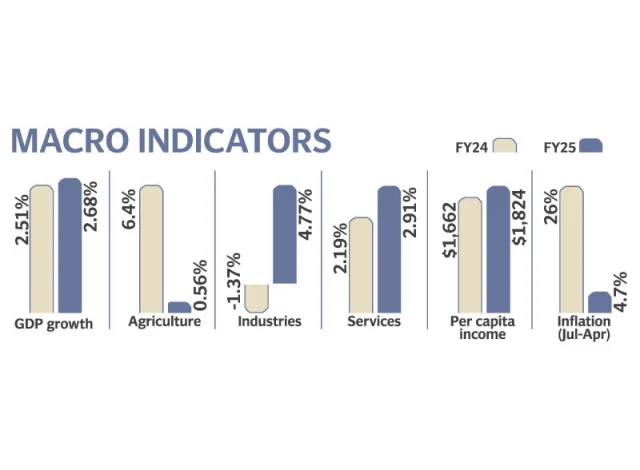
Aurangzeb Eyes Economic Turnaround Amid Questioned Growth Claims
Finance Minister Muhammad Aurangzeb on Monday expressed cautious optimism about Pakistan’s economic recovery, claiming the country is poised for an “economic turnaround” in the upcoming fiscal year, despite falling short of critical growth and revenue targets.
Unveiling the Economic Survey of Pakistan 2024–25 ahead of the federal budget announcement, Aurangzeb maintained that the economy grew by 2.7% during the outgoing fiscal year—below the targeted 3.6% and under dispute from independent economists.
“We have consolidated recovery without triggering a sugar rush,” the minister said, highlighting IMF-backed reforms and fiscal discipline. He acknowledged concerns about the 2.7% growth figure and offered to form a private-sector committee to review the data for discrepancies. Despite this, he maintained: “The data has been provided by the government, and we will stick to it.”
Disputed Data & Economic Performance
To meet the reported 2.7% growth, GDP would have to surge by 5.3% in Q4, with large-scale manufacturing growing over 8%—a scenario analysts consider unlikely. While electricity sector value addition was claimed to have increased by 39.3%, generation throughout the year reportedly declined. Similarly, a 6.6% growth in the construction sector was reported despite sluggish demand and tax burdens.
The agriculture sector, a major contributor to GDP, contracted sharply. Wheat production fell 9% to 29 million metric tons (though the Ministry of Finance earlier projected 26 million tons). Maize, rice, and sugarcane also posted negative growth, while cotton output plunged by 31%.
Sectoral Growth Summary
- Agriculture: Key crop output declined by 13.5%. Minor crops rose 4.8%, aided by increased potato, mango, and onion production.
- Industry: Claimed growth of 4.77% was offset by contractions in mining (-3.4%) and large-scale manufacturing (-1.53%). The electricity and gas sector showed a 28.9% increase, attributed to a low base effect.
- Services: Grew by 2.91%, driven by IT (6.5%), public administration (9.92%), and financial services (3.22%). Wholesale and retail trade posted marginal 0.14% growth due to weak agriculture and manufacturing output.
Fiscal Performance & Revenue Challenges
Aurangzeb admitted the government missed its tax revenue target by over Rs1 trillion. Still, he defended efforts to broaden the tax base, citing an increase in return filers and registered retailers. He said the Federal Board of Revenue’s (FBR) transformation plan would take 2–3 years to bear fruit.
Despite revenue setbacks, the government claims success on inflation control, with the rate falling to 4.6%—well below the 12% target. Per capita income reportedly increased to $1,824, and the economy’s size is estimated at $411 billion.
Pakistan’s current account remained in surplus, with foreign exchange reserves at $11.5 billion. The government also lauded the Roshan Digital Account initiative and Pakistan Remittances Initiative for boosting inflows, which are projected to reach $38 billion this year.
NFC Formula Shift Proposed
Aurangzeb called for a revision of the National Finance Commission (NFC) award formula, proposing a reduction in the 82% weightage given to population. He urged that factors like area, poverty, and revenue generation gain greater weightage to curb population growth incentives and promote equity—a key point ahead of NFC talks scheduled for August.
Investment Lagging, Reforms Continue
Investment-to-GDP ratio missed its 14.2% target, staying at 13.8%, while private investment remained stagnant at 9.1%. The Special Investment Facilitation Council (SIFC) is expected to play a vital role in attracting foreign investment, especially in energy, IT, and mining.
Despite challenges, Aurangzeb reiterated the government’s commitment to staying the course on reforms, avoiding short-term populist measures in favor of structural stability.






